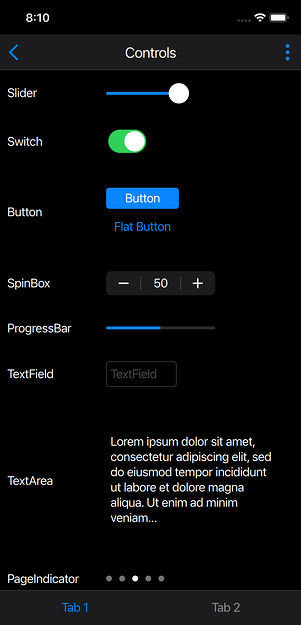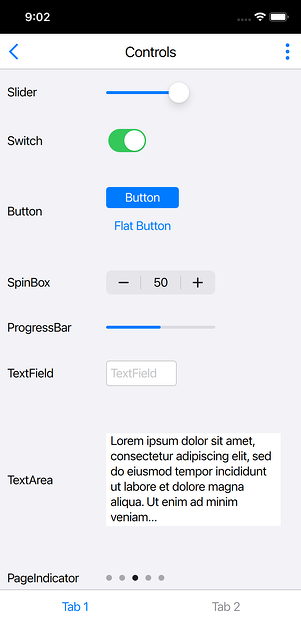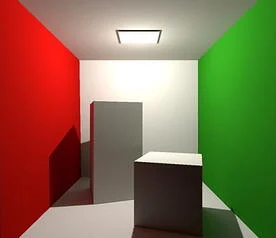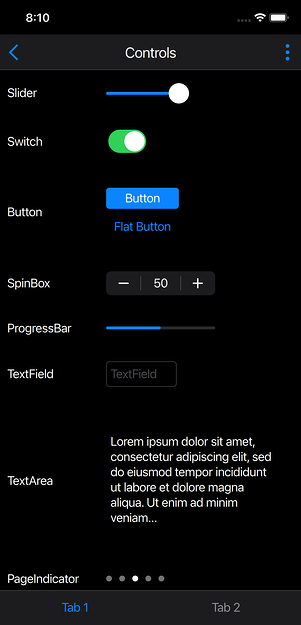Qt 6.4 is released. This release includes several new features such as Qt HTTP Server and Qt Quick 3D Physics, which are briefly described below:
WebAssembly
In Qt 6.4, WebAssembly support is no longer limited to the previous “Technology Preview” phase, and now supports the use of Qt for WebAssembly to build applications for the web platform.
new module
iOS style of Qt Quick (TP)


User interfaces developed using Qt Quick Controls automatically use native styling support for Windows and macOS, and Android using Material styling.
while Qt 6.4 Added native styles for Qt Quick apps running on iOS.The iOS style supports dark and light modes on the iOS platform and also works on macOS.
Qt HTTP Server (TP)
The new module makes it easy to add an HTTP server to any Qt application. The server implements partial support for HTTP 1.1 and supports security through Transport Layer Security.
The documentation mentions that it’s more of a local/LAN-based web service for embedded applications and doesn’t have the robustness and security of an Internet-facing web server. (runs only in trusted networks)
Qt Quick 3D Physics (TP)
The new Qt Quick 3D Physics module provides a high-level physics simulation API that supports simulating interactive rigid bodies, as well as static meshes and non-colliders for detecting overlapping. Each simulated object can have its own physical properties such as mass, density and friction.
Integrate physics simulation into Qt Quick 3D to easily build 3D scenes that move and interact naturally. Such scenes and animations would previously have to be done by hand, which can be quite laborious, but using the Qt Quick API makes it easy to add physics content to any 3D scene.
The module is based on the mature, well tested and high performance PhysX engine.
Qt TextToSpeech
Qt applications support assistive technologies by default, such as screen readers, and multiple applications can use additional text to participate in speech synthesis.
new function
Qt Quick 3D
usepre-generatedLightmaps support global illumination, allowing the creation of more realistic 3D scenes with different light sources, while keeping runtime performance costs to a minimum.This feature is in an early technology preview stage.

Additionally, line particles, support for specular materials, reflection probes, skyboxes, custom materials and textures have been added to the toolbox for more configuration options.
Qt Quick Project View
Added more functionality to Qt Quick’s TableView and TreeView types:
- Users can now navigate using the keyboard and select rows and columns.
- Application developers have more control over cell positioning, animation, and expanding and collapsing tree nodes.
Smoother animations in Qt Quick
A new FrameAnimation animation type has been added, which allows code to run synchronously with animation frames.
Full support for RHI’s QQuickWidget
Use QQuickWidget to build application user interfaces in which Qt Quick and Qt Widget elements coexist. But so far, it requires the use of OpenGL.
The Qt 6.4 release has redesigned this class from the ground up, and now QQuickWidget works with all supported graphics APIs: Metal, Vulkan, Direct3D 11, and OpenGL.
Qt Multimedia
Added a FFMPEG-based multimedia backend that provides consistent audio and video functionality across all platforms. For video playback, improved color space handling and HDR support, and applications can inject subtitles into QVideoFrames.
A new feature under Technology Preview is support forspatial audio,It is possible to create 3D sound scenes in which Qt simulates virtual rooms with sound signatures based on the size of the room, the materials of the walls and floors, and the position of the listener, a feature in technology preview.
Useful new features in Qt Widgets
Qt 6.4 added APIs to control the visibility of rows in form layouts and jump to any page in the wizard.
An optional clear button has been added to QKeySequenceEdit, useful for building complex applications with keyboard shortcuts.
QML
- Better support for value types makes it easier to expose structured data from C++ to QML. Value types and value type lists can be used on properties without the overhead of a QObject wrapper.
- On the tooling side, the QML language server provides real-time feedback in QML-enabled IDEs.
- The QML linter now recognizes inefficient or inappropriate use of Qt Quick and Qt Quick Controls and generates warnings at build time.
- The QML type compiler is enabled by default, and more QML can be compiled into C++.
The next release, Qt 6.5, will have long-term support for commercial users, in addition, Qt Location is being ported to Qt 6, improved theme support for Windows 11 and Linux desktops, and improved QML with compiler tools and better value type support performance. For more details on Qt 6.5, check out the Qt Future Roadmap workshop.
A full list of all contributors to the Qt source code can be found in the release notes
#officially #released #adding #large #number #modules #http #server #physics #light #News Fast Delivery
